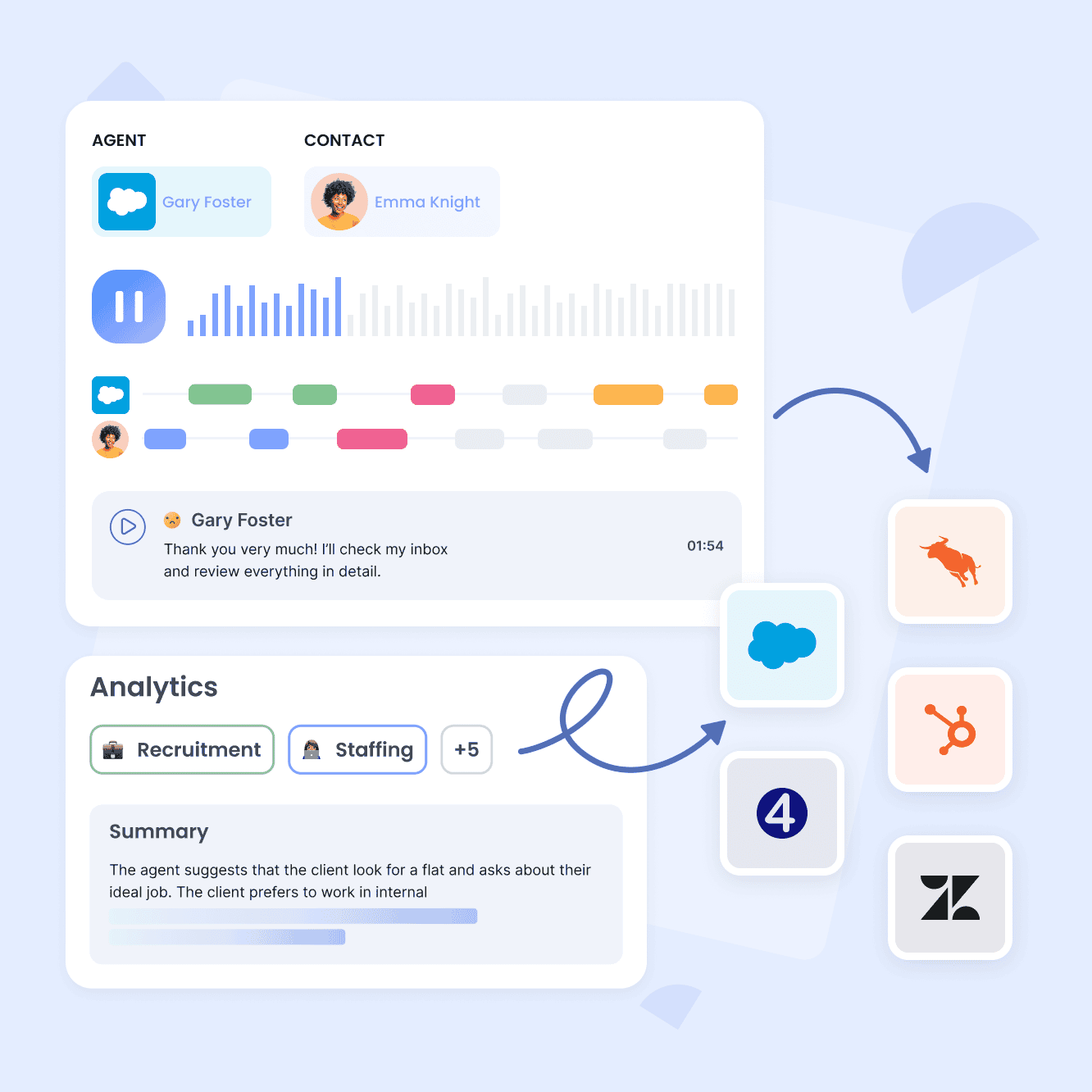Conversational AI Software
Conversations that
move your business forward
AI that elevates communication into a growth engine—boosting team performance and driving measurable results.
From prep to close, Empower has you covered
At every stage of your conversation journey, Empower helps you prepare smarter, perform better, and keep improving with every interaction.
Before the conversation
Prepare with AI-powered simulations. Practice realistic scenarios, refine your approach, and build confidence before every interaction.
Learn moreDuring the conversation
Receive real-time AI guidance and insights to stay focused, respond faster, and communicate with impact.
Learn moreAfter the conversation
Turn insights into improvement with post-call analysis. Review summaries, scores, and recommendations to grow from every conversation.
Learn moreComplete Coverage for Every Call
From phone to video calls, get instant transcriptions, summaries, and key details automatically synced to your tools. Save time, stay organised, and keep every conversation clear.

Actionable Insights After Every Call
AI-powered post-call analysis turns conversations into insight. Review key takeaways, scores, and frameworks—or simply ask Ask Empower for instant answers and deeper context.

Visibility That Fuels Performance
Gain complete visibility into communication quality with advanced analytics. Track KPIs, measure progress, and uncover areas for improvement across teams to drive consistent performance.




See Empower in action
Request a demoDiscover Empower’s key features
Custom Call Score
Evaluate your calls using custom business criteria.
“Thanks to Empower, each salesperson now spends 30 minutes less per day on manual tasks.”
Ricardo GonzálezHead of Sales B2C ThePower Business School
See why others trust us
Boost Sales Performance with AI Sales
Empower helps sales teams master conversations, close more deals, and coach smarter. From prep to follow-up, AI delivers insights automatically synced with your CRM for measurable growth.

Deliver Exceptional Customer Experiences Support
Empower analyses every interaction to help support teams respond faster, resolve issues efficiently, and ensure consistent quality—with summaries and insights synced to your ticketing tools.

Hire Smarter and Faster with AI Recruitment
Empower transcribes, summarises, and analyses interviews—helping recruiters save time on manual tasks, uncover deeper insights, and keep everything synced with your ATS automatically.
Start simple. Scale smart.
Empower’s core licence with flexible add-ons
Empower
£39 / user / month excl. VAT
All-in-one Conversational AI to analyse, learn, and grow from every call.
- Capture every call with clarity
- Unlock insights that drive action
- Personalise AI to your workflow
- Improve performance through coaching
AIRO Coach
Real-time AI guidance that keeps every conversation focused, clear, and effective.
Pitch Room
Train with realistic AI simulations that help you refine skills and master every conversation.
Connect Empower to your everyday tools
Access call summaries, insights, and next steps right where you work—seamlessly integrated with your CRM and business apps.
Explore our marketplace
Conversational AI Software FAQ
- What is Empower by Ringover?
- What are the main features of the conversational AI platform Empower?
- How does Empower improve team training?
- Is Empower compatible with other professional tools?
- How does sentiment analysis work?
- What are the benefits of Empower’s conversational intelligence software for businesses?
- Is Empower easy to set up?
- Can I try Empower before buying it?
- In which languages is Empower available?
- How can I get technical support for Empower?
- What is conversational AI?
What is Empower by Ringover?
Empower by Ringover is conversational AI software designed to help businesses optimize interactions with their customers and prospects. Thanks to advanced features such as call transcription, sentiment analysis, personalised recommendations, and automatic summary generation, this conversation intelligence software helps teams improve the quality of customer service and strengthen their business strategies.
What are the main features of the conversational AI platform Empower?
- Call transcription and call summaries
- Customer sentiment analysis with recommendations on tone and conversation pacing
- Automatic identification of key topics discussed during calls
- Advanced AI statistics on the quality and content of interactions
- Transcription translation in multiple languages (English, Spanish, German, Italian, Portuguese, Dutch, French)
- Integrations with business tools: CRM, telephony, helpdesk, etc.
- Call catalogue and call tags for efficient transcription classification
How does Empower improve team training?
Empower analyses agent performance by tracking key indicators such as the frequency of interruptions or speaking time management. It provides personalized feedback to improve communication skills, the effectiveness of sales pitches, and the quality of customer service.
Is Empower compatible with other professional tools?
Yes, Empower easily integrates with platforms like CRMs, business phone systems like Ringover, and helpdesk tools, allowing centralized and efficient management of customer interactions. You can find all Empower integrations here.
How does sentiment analysis work?
The Empower conversation intelligence software detects the emotional tone of conversations to assess customer satisfaction based on the transcriptions. This helps adapt future communications and improve the customer experience.
What are the benefits of Empower’s conversational intelligence software for businesses?
- Enhanced personalization of customer service
- Increased productivity through automation and advanced analysis
- Better decision-making based on conversation analysis
- Optimisation of sales cycle and customer retention processes
Is Empower easy to set up?
Yes, Empower is a 100% cloud-based solution, deployable in just a few clicks without requiring advanced technical skills. Over time, you can easily specify the relevant terms to track based on your strategy and business needs.
Can I try Empower before buying it?
Yes, Ringover offers a free trial for its conversational intelligence software, allowing businesses to explore Empower’s features before full deployment and integration.
In which languages is Empower available?
Empower supports transcription and translation in multiple languages, including English, Spanish, Dutch, Italian, German, Portuguese, and French, making it easy to use for international activities.
How can I get technical support for Empower?
What is conversational AI?
Conversational AI refers to the use of artificial intelligence to interact with users through natural language, both written and spoken. It relies on technologies like natural language processing (NLP) and machine learning, enabling systems to understand, analyze, and respond to requests smoothly.
Among a conversational AI platform’s main applications are chatbots, virtual assistants, and automated conversational analysis solutions like Empower. Here are some advantages of conversational AI platforms:
- Better understanding of customers
- Identification of best sales and customer support practices
- Optimization of new hire onboarding to facilitate adaptation
- Identification and analysis of trends through customer interactions